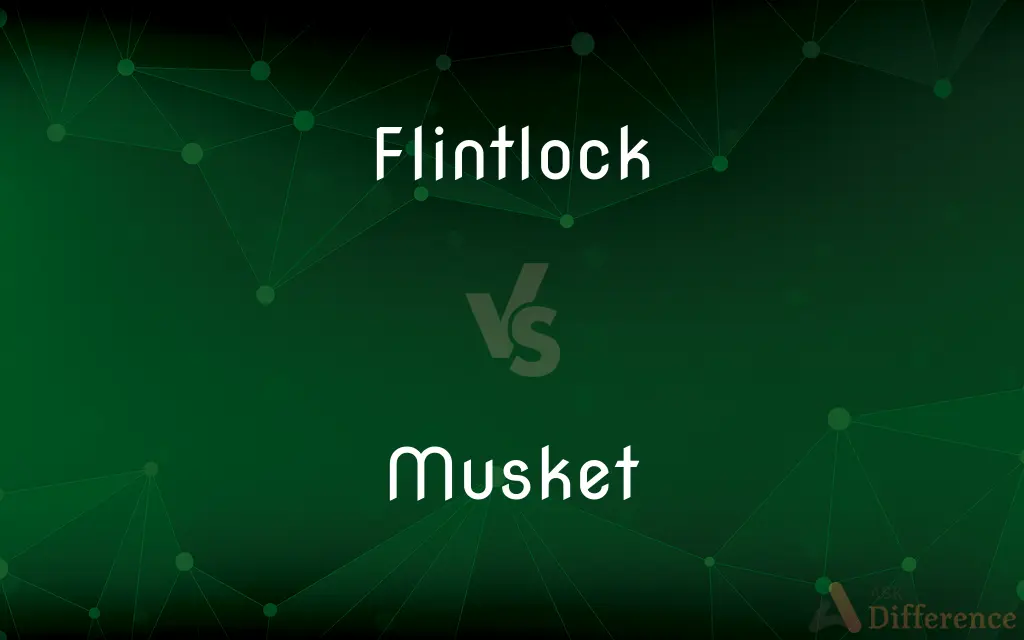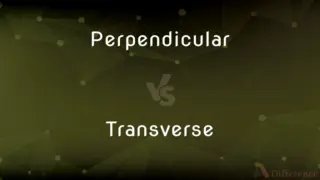Flintlock vs. Musket — What's the Difference?
By Urooj Arif & Maham Liaqat — Updated on March 17, 2024
Flintlock refers to a specific ignition system in firearms, while musket is a type of long gun that may use a flintlock mechanism.

Difference Between Flintlock and Musket
Table of Contents
ADVERTISEMENT
Key Differences
Flintlock is an ignition system for firearms that was prevalent from the 17th to the 19th century, characterized by a piece of flint striking steel to produce sparks. Muskets, on the other hand, were a primary type of infantry weapon before the advent of rifles, and many muskets used the flintlock mechanism for firing.
While the term "flintlock" specifically refers to the mechanism of igniting gunpowder in a firearm, "musket" describes a category of long guns that could utilize various ignition systems, including matchlock, wheellock, or flintlock. This distinction highlights that all flintlocks are part of the firing mechanisms, whereas muskets are the firearms themselves, which could incorporate different types of ignition systems.
Flintlock mechanisms are known for their reliability and relatively quick reloading time compared to earlier ignition systems like the matchlock, making them popular in military use. Muskets, especially those equipped with flintlock mechanisms, were valued for their ease of use and effectiveness in volleys, a common military tactic of the time.
The evolution of firearms technology saw the flintlock mechanism eventually replaced by the percussion cap system in the early 19th century, due to its greater reliability and resistance to weather. However, muskets continued to be used until they were gradually supplanted by rifles, which offered greater accuracy due to their rifled barrels.
Comparison Chart
Definition
An ignition system in firearms
A type of long gun
ADVERTISEMENT
Use
17th to 19th century
Before the advent of rifles
Key Feature
Flint striking steel to produce sparks
Could use various ignition systems
Significance
Improved reliability and reloading time
Main infantry weapon in its era
Technological Evolution
Replaced by percussion cap system
Replaced by rifles
Compare with Definitions
Flintlock
A mechanism for igniting gunpowder in firearms, using flint and steel.
The flintlock pistol was a favored sidearm in the 18th century.
Musket
A long gun that was the primary infantry weapon in past centuries.
The musket was the backbone of the 17th-century infantry.
Flintlock
Used in a variety of firearms, including pistols and rifles.
The flintlock rifle became popular among frontiersmen for its accuracy.
Musket
Known for its use in massed volleys by infantry units.
Infantry units fired muskets in volleys to break enemy lines.
Flintlock
Known for its reliability compared to earlier ignition systems.
Soldiers preferred flintlock muskets for their dependability.
Musket
Could be equipped with different ignition systems, including flintlock.
The flintlock musket revolutionized warfare with its quick reloading.
Flintlock
Characterized by the spark produced when flint strikes a steel frizzen.
The distinctive sound of a flintlock's spark marked the beginning of the duel.
Musket
Eventually replaced by rifles due to the latter's superior accuracy.
The introduction of rifled barrels made muskets obsolete.
Flintlock
Became obsolete with the invention of the percussion cap.
The invention of the percussion cap system marked the end of the flintlock era.
Musket
Played a crucial role in the military tactics of its time.
Muskets, bayonets, and formation tactics dominated 18th-century battlefields.
Flintlock
Flintlock is a general term for any firearm that uses a flint striking ignition mechanism. The term may also apply to a particular form of the mechanism itself, also known as the true flintlock, that was introduced in the early 17th century, and gradually replaced earlier firearm-ignition technologies, such as the matchlock, the wheellock, and the earlier flintlock mechanisms.
Musket
A musket is a muzzle-loaded long gun that appeared as a smoothbore weapon in the early 16th century, at first as a heavier variant of the arquebus, capable of penetrating heavy armor. By the mid-16th century, this type of musket went out of use as heavy armor declined, but the term musket continued as the name given for any hand held long gun until the mid-19th century.
Flintlock
An obsolete gunlock in which a flint fixed in the hammer produces a spark that ignites the charge.
Musket
A smoothbore shoulder gun used from the late 1500s through the early 1800s.
Flintlock
A firearm having this type of gunlock.
Musket
A kind of firearm formerly carried by the infantry of an army, originally fired by means of a match, or matchlock, for which several mechanical appliances (including the flintlock, and finally the percussion lock) were successively substituted; ultimately superseded by the rifle.
Soldier, soldier, won't you marry me, with your musket, fife and drum.
Sam, Sam, pick up thy musket.
Flintlock
An early type of firearm, using a spring-loaded flint to strike sparks into the firing pan.
Musket
(falconry) A male Eurasian sparrowhawk (Accipiter nisus).
Flintlock
A type of lock used on muskets, rifles, and pistols from the early 17th to the mid-19th century.
Musket
The male of the sparrow hawk.
Flintlock
A lock for a gun or pistol, having a flint fixed in the hammer, which on striking the steel ignites the priming.
Musket
A species of firearm formerly carried by the infantry of an army. It was originally fired by means of a match, or matchlock, for which several mechanical appliances (including the flintlock, and finally the percussion lock) were successively substituted. This arm has been completely superseded by the rifle, and is now only of historical interest.
Flintlock
A hand firearm fitted with a flintlock; esp., the old-fashioned musket of European and other armies.
Musket
A muzzle-loading shoulder gun with a long barrel; formerly used by infantrymen
Flintlock
A muzzle loader having a flintlock type of gunlock
Flintlock
A gunlock that has flint embedded in the hammer; the flint makes a spark that ignites the charge
Common Curiosities
What is a musket?
A musket is a type of long gun that was used as the primary infantry weapon before rifles became prevalent.
How does a flintlock work?
A flintlock works by releasing a spring-loaded hammer that holds a piece of flint, striking it against a steel frizzen to create sparks that ignite the gunpowder.
What replaced the flintlock mechanism?
The percussion cap system replaced the flintlock mechanism due to its greater reliability and resistance to wet conditions.
What is a flintlock?
A flintlock is an ignition system for firearms that produces sparks by striking flint against steel.
What made flintlock muskets popular in military use?
Flintlock muskets were popular due to their relatively quick reloading time and reliability compared to earlier ignition systems.
Are flintlock firearms still in use today?
Flintlock firearms are no longer used in practical applications but are collected and used in historical reenactments.
Can a musket have a flintlock mechanism?
Yes, many muskets were equipped with flintlock mechanisms, especially during the 17th to 19th centuries.
Why were muskets replaced by rifles?
Muskets were replaced by rifles because rifled barrels provided greater accuracy and range.
Were flintlocks used in pistols as well as muskets?
Yes, flintlock mechanisms were used in various firearms, including pistols, rifles, and muskets.
Did all muskets use the flintlock mechanism?
Not all muskets used the flintlock mechanism; earlier muskets used matchlock or wheellock systems.
What is the main difference between a flintlock and a musket?
The main difference is that a flintlock is a type of ignition system, while a musket is a type of firearm that may use a flintlock or other ignition systems.
How did weather conditions affect flintlock mechanisms?
Flintlock mechanisms could be affected by wet conditions, which might prevent the flint from sparking effectively.
How did the use of muskets impact military tactics?
Muskets, used in volleys by massed infantry, were a central element of military tactics, enabling concentrated firepower.
How did the invention of the percussion cap improve firearms?
The percussion cap improved firearms by providing a more reliable ignition system that was less susceptible to weather conditions.
What role did muskets play in historical warfare?
Muskets were the primary infantry weapons in historical warfare, central to the tactics and strategies of armies from the 16th to the early 19th centuries.
Share Your Discovery

Previous Comparison
Perpendicular vs. Transverse
Next Comparison
Sear vs. ScorchAuthor Spotlight
Written by
Urooj ArifUrooj is a skilled content writer at Ask Difference, known for her exceptional ability to simplify complex topics into engaging and informative content. With a passion for research and a flair for clear, concise writing, she consistently delivers articles that resonate with our diverse audience.
Co-written by
Maham Liaqat















































